|
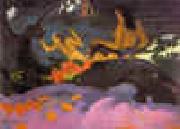 |
Paul Gauguin
|
|
French
1848-1903
Paul Gauguin Art Locations
(born June 7, 1848, Paris, France ?? died May 8, 1903, Atuona, Hiva Oa, Marquesas Islands, French Polynesia) French painter, sculptor, and printmaker. He spent his childhood in Lima (his mother was a Peruvian Creole). From c. 1872 to 1883 he was a successful stockbroker in Paris. He met Camille Pissarro about 1875, and he exhibited several times with the Impressionists. Disillusioned with bourgeois materialism, in 1886 he moved to Pont-Aven, Brittany, where he became the central figure of a group of artists known as the Pont-Aven school. Gauguin coined the term Synthetism to describe his style during this period, referring to the synthesis of his paintings formal elements with the idea or emotion they conveyed. Late in October 1888 Gauguin traveled to Arles, in the south of France, to stay with Vincent van Gogh. The style of the two men work from this period has been classified as Post-Impressionist because it shows an individual, personal development of Impressionism use of colour, brushstroke, and nontraditional subject matter. Increasingly focused on rejecting the materialism of contemporary culture in favour of a more spiritual, unfettered lifestyle, in 1891 he moved to Tahiti. His works became open protests against materialism. He was an influential innovator; Fauvism owed much to his use of colour, and he inspired Pablo Picasso and the development of Cubism.
|
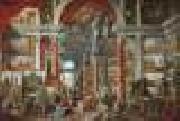 |
PANNINI, Giovanni Paolo
|
|
Italian Neoclassical Painter, ca.1691-1765
was an Italian painter and architect, mainly known as one of the vedutisti or (veduta, or "view painters"). As a young man, Pannini trained in his native town of Piacenza as a stage designer. In 1711, he moved to Rome, where he studied drawing with Benedetto Luti and became famous as a decorator of palaces, including the Villa Patrizi (1718C1725) and the Palazzo de Carolis (1720). As a painter, Pannini is best known for his vistas of Rome, in which he took a particular interest in the city's antiquities. Among his most famous works are the interior of the Pantheon, and his vedute paintings of picture galleries containing views of Rome. Most of his works, specially those of ruins have a substantial fanciful and unreal embellishment characteristic of capriccio themes. In 1719, Pannini was admitted to the Congregazione dei Virtuosi al Pantheon. He taught in Rome at the Accademia di San Luca and the Academie de France, where he influenced Jean-Honore Fragonard. His studio included Hubert Robert and his son Francesco Panini. His style would influence a number of other vedutisti, such as his pupil Antonio Joli, as well as Canaletto and Bernardo Bellotto, |
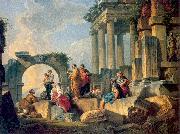 |
Panini, Giovanni Paolo
|
|
Italian Neoclassical Painter, ca.1691-1765
Italian painter, architect and stage designer. He was a highly prolific and versatile painter, best known for his numerous vedute of Rome, many of which focused on the remnants of the city's Classical past. Ceremonies and festivals often feature in his vedute, which thus constitute a lively documentation of contemporary topography, lifestyle and customs. In contrast to Bernardo Bellotto and Gaspar van Wittel, his treatment is picturesque rather than rigorous; he liked to enliven and animate his views by adding numerous figures. He worked exclusively in Rome and by the end of his career was the head of a thriving workshop that included the Frenchman Hubert Robert (in Rome from 1754) and Panini's son Francesco Panini (b 1738). |
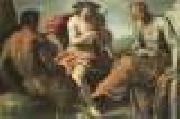 |
PALMA GIOVANE
|
|
Italian Mannerist Painter, ca.1548-1628
Son of Antonio Palma. A greater artist than his father, his vast oeuvre represents the impact of central Italian Mannerism but principally of Jacopo Tintoretto on Venetian painting in the generation after Titian, Tintoretto and Paolo Veronese. He died in his late seventies and was occasionally referred to as 'il vecchio', but since the 17th century he has been known as 'il giovane' to distinguish him from his great uncle. He was virtually self-taught, apart from a presumed acquaintance with his father's workshop. In 1567 he came to the attention of Guidobaldo II della Rovere, Duke of Urbino, who was to support him for four years. A possible knowledge of Federico Barocci's art at the court of Urbino left little trace on his surviving early works. The Duke sent him to Rome for study, where he spent a few months apprenticed to an unknown artist. There his sympathy was with Taddeo Zuccaro and Federico Zuccaro, who influenced the graphic style of the drawing of Matteo da Lecce (1568; New York, Pierpont Morgan Lib.), his first dated work. His Roman sojourn, which lasted until c. 1573-4, made a direct impact on some of his Venetian works and indirectly made him receptive to Tintoretto's style. A tendency in Rome in the 1560s to retreat from the most artificial and decorative aspects of Mannerism in favour of naturalism was also to affect Palma's attitude to style in his mature works |
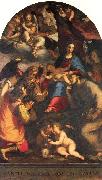 |
Paggi, Giovanni Battista
|
|
Italian Baroque Era Painter, 1554-1627
.Italian painter and theorist. As the son of a newly inscribed nobleman, he received a Renaissance gentleman's education, but as an artist he was it seems self-taught, despite the encouragement of Luca Cambiaso. The gentleman who then set up as a painter was obliged to give his work to patrons, sometimes expecting future remuneration; but when one patron reneged on payment in 1581, Paggi mortally wounded him and was banished from Genoa. He was given protection by Francesco I de' Medici, Grand Duke of Tuscany, and settled in Florence. A fresco of St Catherine Converting Two Criminals (1582), painted for Niccol? Gaddi's family chapel at S Maria Novella and thoroughly Florentine in manner, established Paggi's reputation at the Medici court. He painted ephemeral decorations, portraits (all untraced) and altarpieces for many Florentine churches and for the cathedrals of San Gimignano (c. 1590), Pistoia (1591-3) and Lucca (1597-8), |
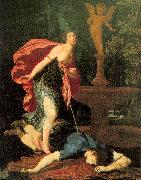 |
Pagani, Gregorio
|
|
Italian, 1558-1605
Italian painter. He trained in the studio of the Late Mannerist Maso da San Friano, but then studied with the more progressive Santi di Tito. There he became friends with Ludovico Cigoli: the two artists, who desired to renew the art of painting, studied from nature and developed an interest in Venetian and Emilian art. Pagani was deeply influenced by Correggio. His earliest surviving works include the frescoes of the Confirmation of the Rule of St Dominic (c. 1580; Florence, S Maria Novella, Chiostro Grande) and the Meeting between SS Dominic and Francis (Florence, Convento dei Cappuccini di Monturghi). In 1592 he painted the Virgin and Saints (St Petersburg, Hermitage), a work that already reveals his interest in Correggio. In the same year he painted a Finding of the True Cross (untraced), a daring composition that is preserved in preparatory drawings. A number of works from the 1590s survive and show Pagani's interest in Emilian art; the Crucifixion and Saints (1595; Florence, S Bartolomeo in Pozzo) and the Virgin and Child with SS Michael the Archangel and Benedict (1595; Florence, S Michele Arcangelo Le Ville). At the turn of the century Pagani was increasingly associated with those Florentine artists who wished to develop a new narrative clarity and directness. His pictures (e.g. Pyramus and Thisbe; Florence, Uffizi) show figures carefully posed with varied expressions and gestures. In the early 17th century Pagani became yet more attracted by naturalism, as in the St Lawrence (1600) in the basilica of the Madonna delle Grazie at San Giovanni, Valdarno. Through his friendship with Bartolomeo Carducho he was influenced by Spanish art, as is evident in the Adoration of the Magi |
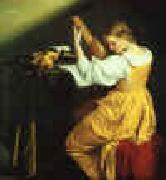 |
Orazio Gentileschi
|
|
1563-1639 Italian Orazio Gentileschi Galleries Tuscan painter, b. Pisa. His real surname was Lomi, but he adopted his uncle name. He studied in Rome, where he was associated with Agostino Tassi in the decoration of palace interiors. Influenced by Caravaggio, Gentileschi developed a more softly luminous light and a cooler, more lyrical style. He also painted frescoes in Santa Maria Maggiore and in the Lateran. After spending several years in Genoa and in France, he settled in England (1626) at the invitation of Charles I. Gentileschi principal works include The Annunciation (San Siro, Genoa); Flight into Egypt (Louvre); Sibyl (Hampton Court, England); and Moses Saved from the Waters (Prado). He also painted numerous portraits. Artemesia Gentileschi was his daughter. |
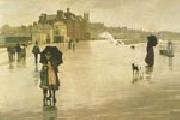 |
Norman Garstin
|
|
(28 August 1847 ?C 22 June 1926) was an Irish artist associated with the Newlyn School of painters.
He was born in Caherconlish, Co. Limerick, Ireland, and was involved in various professions such as journalism and gold mining in South Africa. In 1885 he befriended members of the Newlyn School and settled there a year later, moving to nearby Penzance in 1890.
The Rain it Raineth Every Day 1889His work consisted primarily of small oil panels in the plein air style, something he had picked up from the French Impressionists such as Edouard Manet and Edgar Degas. |
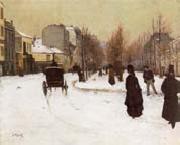 |
Norbert Goeneutte
|
|
French Painter, 1854-1894.French painter and engraver. In 1871, after working briefly as a lawyers clerk, he entered the studio of Isidore Pils at the Ecole des Beaux-Arts. When Pils died in 1875 Henri Lehmann took over the studio and Goeneutte left, moving to Montmartre. There he met Auguste Renoir, for whom he often modelled, and Marcellin Desboutin, who inspired his interest in engraving, etching and drypoint. Although Goeneutte was associated with Manet, Degas and Renoir, and his work was influenced by them, for instance in the informality of his compositions, he never exhibited with the Impressionist group, preferring instead the official Salons. Every year from 1876 he exhibited several works in the Paris Salon, such as Boulevard de Clichy under Snow (1876; London, Tate). He visited London in 1880, Rotterdam in 1887 and Venice in 1890. |
 |
Norbert Goeneutte
|
|
1854-1894
French
French painter and engraver. In 1871, after working briefly as a lawyer's clerk, he entered the studio of Isidore Pils at the Ecole des Beaux-Arts. When Pils died in 1875 Henri Lehmann took over the studio and Goeneutte left, moving to Montmartre. There he met Auguste Renoir, for whom he often modelled, and Marcellin Desboutin, who inspired his interest in engraving, etching and drypoint. Although Goeneutte was associated with Manet, Degas and Renoir, and his work was influenced by them, for instance in the informality of his compositions, he never exhibited with the Impressionist group, preferring instead the official Salons. Every year from 1876 he exhibited several works in the Paris Salon, such as Boulevard de Clichy under Snow (1876; London, Tate). He visited London in 1880, Rotterdam in 1887 and Venice in 1890. |
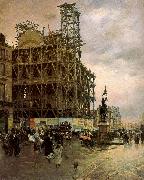 |
Nittis, Giuseppe de
|
|
Italian, 1846-84
Italian painter, pastellist and printmaker. Throughout his career he was committed to a plein-air aesthetic and was particularly interested in rendering varying light effects, a concern that brought him into contact with the Impressionists. He was also acquainted with the members of the Macchiaioli, for whom his work was influential. In addition to oils, he experimented with printmaking and made innovative use of pastels. Practising a restrained, and therefore 'acceptable', form of Impressionism, he achieved great success in his lifetime, |
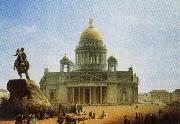 |
nikolay gogol
|
|
With the works of the Russian author Nikolai Gogol (1809-1852) the period of Russian imitation of Western literature ended. He found inspiration in native materials and combined realistic detail with grotesque and otherworldly elements. |
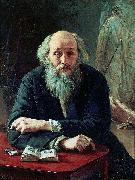 |
Nikolai Ge
|
|
1831 C 13 June [O.S. 1 June] 1894) was a Russian realist painter famous for his works on historical and religious motifs.
Nikolai Ge was born in Voronezh to a Russian noble family of French origin. His grandfather emigrated to Russia in the 18th century. His parents died when he was still a child, so Nikolai was raised by his serf nurse. He graduated from the First Kiev Gymnasium and studied at the physics-mathematics department of Kiev University and Saint Petersburg University.
In 1850 he gave up his career in science and entered the Imperial Academy of Arts in Saint Petersburg. He studied in academy under the historical painter Pyotr Basin until 1857. He graduated from the academy in 1857 with a gold medal for his painting The Witch of Endor Calling Up the Spirit of the Prophet Samuel. According to Ge himself, during that period he was strongly influenced by Karl Brullov.
His gold medal provided him a scholarship for studying abroad . He visited Germany, Switzerland, France and in 1860 settled in Italy. In Rome he met Alexander Andreyevich Ivanov who strongly influenced Ge. In 1861 Ge painted The Last Supper; in 1863 he took the painting with him to Saint Petersburg. Ge found his own interpretation of the classical subject ?? he emphasized the motif of discord among those who had formerly shared the same views. The painting (bought by Tsar Alexander II of Russia) made so strong impression that Ge was made a professor of Imperial Academy of Arts.
In 1864 he returned to Florence where he became a friend of a major Russian pro-Western writer and thinker Alexander Herzen and painted his portrait. The same year he also painted Messengers of the Resurrection and the first version of the Christ on the Mount of Olives. |
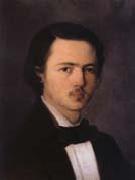 |
Nicolae Grigorescu
|
|
Romanian Painter, 1838-1907
From 1848 he trained in Bucharest with various church painters, producing icons and religious mural decorations. These works, which soon attracted attention, were influenced in style by the Viennese classicism widespread in the Romanian principalities in the early 19th century and by the Italian academicism established there after 1850 by Gheorghe Tattarescu. The earliest of his known paintings are in the church of SS Constantin and Elena at Baicoi, where his signature can be seen beside that of Nita Pereescu on the icon of St George (1853). He subsequently painted a series of icons (1854-5) at Caldarusani Monastery. In the later ensembles he was assisted by his older brother Georghe Grigorescu, who participated under his direction in the decoration of churches, such as those of the Zamfira (1856-8) and Agapia (1858-60) monasteries. In Nicolae's paintings at Agapia, classicism in Romanian art reached its highest point. The royal icons are distinguished for the elegance of the figures, both in their attitudes and in their drapery. |
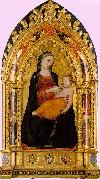 |
Niccolo di Pietro Gerini
|
|
Italian Painter, active ca.1368-1415
died in Florence in 1415, earned reputation of an important Italian painter. He represents giottesque school, in the tradition of the Andrea di Orcagna (1320-1368) and of Taddeo Gaddi. His father Pietro Geri is registered as a member of Lucas Guild in 1339. Niccolo worked mainly in Florence, although he also carried out commissions in Rome (Vatican), Pisa and Prato.
He was first recorded in 1368 as a member of the Arte dei Medici e Speziali in Florence but is identifiable with the Niccolo dipintore who collaborated with Jacopo di Cione on frescoes for the Guildhall of the Judges and Notaries in Florence in 1366. It is self-evident that he is the Niccolaio dipintore who worked with Jacopo di Cione on the altarpiece of the Coronation of the Virgin (presently in London, National Gallery) for St Pier Maggiore, Florence in 1370 and was paid 12 golden florins per disegnare la tavola dell altare in November of the same year. He designed the altarpiece and the elaborate throne canopy with his usual fine painting and detailed ornaments whilst Jacopo di Cione was depicting side saints. This altarpiece is amongst of very few largest commissioned in 14th century Florence. It was seemingly commissioned by Albizzi family.
He was collaborating with Jacopo di Cione on Coronation of the Virgin (Accademia, Florence) in 1372. Offner and Steinweg suggest that he was responsible for the design and fine painting and Jacopo for the execution of saints. It was commissioned by the mint of Florence Zecca Vecchia on the same year.
In 1383 Gerini again worked with Cione on a fresco of the Annunciation in the Palazzo dei Priori, Volterra. This fresco clearly shows the work of two very different artists: Niccolo di Pietro Gerini (design and very fine painting) and Jacopo di Cione (broadly painted saints and side decoration). In 1386 Niccolo frescoed the façade of the Bigallo, Florence. He also frescoed Sant Ambrogio church in Florence
Gerini performed the Crocefissione of St Felicita church in Florence.
His hand is clearly on sacrestia of the basilica of Saint Croce to Florence with Scenes of the life of Christ. Between 1391 and 1392 he worked in Prato where he frescoed Palazzo Datini, church of Saint Francisco with Lorenzo di Niccolo and Agnolo Gaddi.
He also frescoed capitolare of the church of Saint Francisco, Pisa.
Very typically for Gothic depiction Gerini figures have large chins, sloping foreheads, and sharp noses whilst their bodies are squat and frontally displaced.
Another important artist Lorenzo di Niccol?? di Martino was trained in Niccol?? di Pietro Gerini workshop and later collaborated with the master but was not his son as sometimes erroneously stated. Gerini though had a son Bindo di Niccolo di Pietro Gerini, born in 1363, who is registered as member of Lucas Guild since 1408.
Niccolo di Pietro Gerini works can be found in major art galleries of Rome, Vatican, Florence, London, Milan, New York, Los Angeles, Amsterdam, Berlin, Paris, St Petersburg, Boston, Cambridge, Budapest, Birmingham, Pegalo, Prato, Pisa, Altenburg, Avignon, Denver and several other museums. |
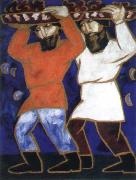 |
natalia goncharova
|
|
natalia goncharova(1881 to 1962),Russian painter, stage designer, printmaker and illustrator. She was a leading artist of the Russian avant-garde in the early 20th century but became a celebrity in the West through her work for SERGE DIAGHILEV and the BALLETS RUSSES. During the 1920s she played a significant role within the Ecole de Paris and continued to live and work in France until her death.
|
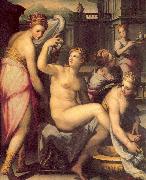 |
Naldini, Giovanni Battista
|
|
Italian, 1537-91
was an Italian painter of a late-Mannerism in Florence. His first apprenticeship (1549-57) was in the studio of Jacopo Pontormo. He went from Rome for a number of months following 1560, and was recruited to work for Giorgio Vasari in 1562. He painted two crowded, mannerist canvas for the Studiolo of Francesco I in the Palazzo Vecchio: the Allegory of Dreams and the Gathering of Ambergris. He supplied altarpieces to Santa Maria Novella and Santa Croce. He painted an altarpiece of Calling of Saint Matthew for the Salviati Chapel in San Marco, where he worked alongside Francesco Morandini. Ultimately, he is aptly described by Freedberg as displaying work distantly derivative from the style of Andrea del Sarto, as expressed by Naldini's two mentors and Sarto's two pupils: Pontormo and Vasari. |
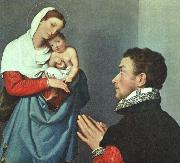 |
MORONI, Giovanni Battista
|
|
Italian Mannerist Painter, ca.1520-1578
.Italian painter. He was the most significant painter of the 16th-century school of Bergamo and is best known for his portraits, which feature a naturalistic rendering of both faces and costume and an objective approach to character. |
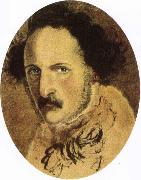 |
mikhail glinka
|
|
Period: Romantic (1820-1869)
Country: Russia
Born: June 01, 1804 in Novospasskoye, Smolensk, Russia
Died: February 15, 1857 in Berlin, Germany
Genres: Chamber Music, Keyboard Music, Miscellaneous Music, Opera, Orchestral Music, Vocal Music
|
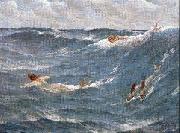 |
Maynard, George Willoughby
|
|
American, 1843-1923
American figure, marine, and mural painter, b. Washington, D.C., studied at the National Academy of Design and in Florence and Antwerp. Maynard created decorations for the Library of Congress and the old Metropolitan Opera House, New York City. |
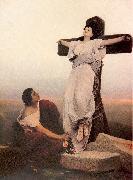 |
Max, Gabriel Cornelius von
|
|
Czechoslovakian, 1840-1915
Painter, illustrator and teacher, nephew of (1) Emanuel Max. He studied at the Academy of Fine Arts, Prague (1855-8), and the Akademie der Bildenden K?nste, Vienna (1858-61), and under Karl Theodor von Piloty at the Akademie der Bildenden K?nste, Munich (1863/4-7). He settled in Munich, where he opened a private school of painting in 1869. His paintings and book illustrations of the second half of the 1860s show an affinity with the late Romanticist movement. He illustrated works of German literature by Wieland, Lenau and Schiller, as well as producing illustrations for Goethe's Faust (1867-8; Prague, N.G., Kinsky Palace). As well as literary and even musical sources, religious themes frequently occur in his work, including his first great success, the Crucifixion of St Julie (1867; ex-Sotheby's, London, 1976). In numerous female figures and portraits Max explored the tension between the inner state and the charm of the physical appearance or surroundings of his subjects. His interest in the artistic perception of relationships between physical reality and the spiritual world led him to a study of anthropology and contemporary occultism and mysticism, as in his portraits of the Seer of Prevorst |
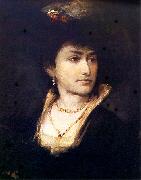 |
Maurycy Gottlieb
|
|
Drohobytsch, February 21/28, 1856 - Krakew, July 17, 1879) was a Jewish painter, of Polish-speaking Galician Jews from the western part of Ukraine. He was born in Drohobych (at that time Austria-Hungary), Galicia, modern Lviv region, western Ukraine.
Maurycy was one of Isaac and Fanya Tigerman Gottlieb's eleven children. At fifteen, he was enrolled at the Vienna Fine Arts Academy. Later, he would study under Jan Matejko in Krakew. However, he experienced anti-semitism from his fellow students, and left Matejko's studio after less than a year, he then traveled to Norway settling in Molde. After several years he returned to Vienna to pursue his Jewish roots.
At twenty, he won a gold medal from a Munich art competition for Shylock and Jessica (at right), showing a scene from Shakespeare's The Merchant of Venice. He based Jessica's face on that of Laura Rosenfeld, to whom he had proposed marriage. However, Rosenfeld rejected his proposal, and wed a Berlin banker. Gottlieb then planned to marry Lola Rosengarten, but when he heard about Rosenfeld's marriage he committed suicide by exposure to the elements, dying of complications from a cold.
Despite his early death, more than three hundred of his works survive, though not all are finished. After the fall of the Iron Curtain, many Polish collections unknown in the West were discovered, and his reputation grew greatly.
His brother, painter Leopold Gottlieb, was born five years after his death.
|
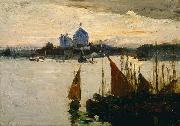 |
Maurice Galbraith Cullen
|
|
Maurice Galbraith Cullen (1866-1934) was a Canadian artist.
Cullen was born June 6, 1866 in St. John's, Newfoundland.
Beginning in January 1918, Cullen served with Canadian forces in the First World War. He came to the attention of Lord Beaverbrook, who arranged for him to be commissioned as an "official war artist" along with Frederick Varley, J.W. Beatty and C. W. Simpson. |
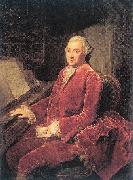 |
Matthieu, Georg David
|
|
German, 1737-1778
German painter and engraver. He received his training as a painter from his father, the Prussian court painter David Matthieu (1697-1755), and his stepmother and aunt, the painter Anna Rosina Lisiewska (1713/16-83). He apparently travelled outside Germany and is known to have gone to Stralsund with the painter Philipp Hackert in 1762. His portraits from this period, including one of Princess Charlotte of Mecklenburg-Strelitz, who married King George III of England, |
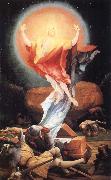 |
Matthias Grunewald
|
|
German Northern Renaissance Painter, ca.1470-1528,was an important German Renaissance painter of religious works, who ignored Renaissance classicism to continue the expressive and intense style of late medieval Central European art into the 16th century. Only ten paintings (several consisting of many panels) and thirty-five drawings survive, all religious, although many others were lost at sea in the Baltic on their way to Sweden as war booty. His reputation was obscured until the late nineteenth century, and many of his paintings were attributed to Albrecht D??rer, who is now seen as his stylistic antithesis. His largest and most famous work is the Isenheim Altarpiece in Colmar, Alsace (now in France). The details of his life are unusually unclear for a painter of his significance at this date, despite the fact that his commissions show that he had reasonable recognition in his own lifetime. His real name remains uncertain, but was definitely not Grunewald; this was a mistake by the 17th-century writer, Joachim von Sandrart, who confused him with another artist. He is documented as "Master Mathis" or "Mathis the Painter" (Mathis der Maler), and as using as surname both Gothart and Neithardt - this last may have been his surname, or more likely that of his wife. He was probably born in Wurzburg in the 1470s. It is possible he was a pupil of Hans Holbein the Elder. From about 1500 he seems to have lived at Seligenstadt, when not working elsewhere. His first dated painting is probably in Munich, dated 1503 on a much later note which apparently records an older inscription. From about 1510 to 1525 he served in the Rhineland as court painter, |
 |
Matthias Grunewald
|
|
German
1475-1528
Matthias Grunewald Galleries
Only religious works are included in his small surviving corpus, the most famous being the Isenheim Altarpiece, completed 1515, now in the Musee d'Unterlinden, Colmar. Its nine images on twelve panels contain scenes of the Annunciation, Mary bathing Christ, Crucifixion, Entombment of Christ, Resurrection, Temptation of St. Anthony and saints. As was common in the preceding century, there are different views, depending on the arrangement of the wings; but the three views available here are exceptional. The third view discloses a carved and gilded wood altarpiece in the centre. As well as being by far his greatest surviving work, the altarpiece contains most of his surviving painting by area, being 2.65 metres high and over 5 metres wide at its fullest extent.
His other works are in Germany, except for a small Crucifixion in Washington and another in Basel, Switzerland. He was asked in about 1510 to paint four saints in grisaille for the outside of the wings of Durer's Heller Altarpiece in Frankfurt. D??rer's work was destroyed by fire and only survives in copies, but fortunately the wings have survived. There are also the late Tauberbischofsheim altarpiece in Karlsruhe, and the Establishment of the Santa Maria Maggiore in Rome (1517-1519), Freiburg, Augustinermuseum. A large panel of Saint Erasmus and Saint Maurice in Munich probably dates from 1521-24, and was apparently part of a larger altarpiece project, the rest of which has not survived. Other works are in Munich, Karlsruhe, and Rhineland churches. Altogether four somber and awe-filled Crucifixions survive. The visionary character of his work, with its expressive colour and line, is in stark contrast to Albrecht Durer's works. His paintings are known for their dramatic forms, vivid colors, and depiction of light. |
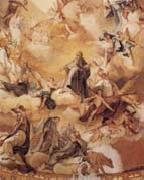 |
Matthaus Gunther
|
|
the most prolific fresco painter of the eight- eenth century in central Europe.
German, 1705-1788
He was an important German painter and artist of the Baroque and Rococo era. Gunther helped develop the rococo style of painting in Bavaria and Tyrol, working on over 40 churches. His known work includes about 70 frescoes and 25 panels. In particular, he was known for his life-like imagery and lively coloring. Gunther studied in Munich from 1723 to 1728 with Cosmas Damian Asam, the older of the two Asam brothers, and perfected his fresco painting in Augsburg. He frequently worked with some of the greatest artists of his time, including the architect Johann Michael Fischer and the plasterer Johann Michael Feuchtmayer and his brother Franz Xaver. |
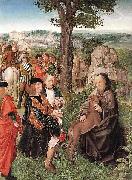 |
Master of Saint Giles
|
|
The Master of Saint Giles (French: Maître de Saint-Gilles) was a Franco-Flemish painter active, probably in Paris, about 1500, working in a delicate Late Gothic manner, with rendering of textures and light and faithful depictions of actual interiors that show his affinities with Netherlandish painting. It is not clear whether the Master of Saint Giles was a French painter who trained in the Low Countries (perhaps more likely), or a Netherlander who emigrated to France.
His pseudonym was given him by Max Friedländer, who reconstructed part of the anonymous painter's oeuvre, starting from two panels devoted to Saint Giles (a Miracle and a Mass) in the National Gallery, London, that were part of the lefthand shutter of an altarpiece, and two further panels now in Washington from the same altarpiece. The hand of an assistant can be discerned in the Baptism of Clovis at the National Gallery of Art, Washington, who also have a panel with Episodes from the Life of a Bishop-Saint - perhaps Saint Leu, Saint Denis or Saint Remy. All four panels have, or had, single grisaille figures of saints (Saints Peter, Giles, Denis and an unidentified bishop-saint) in niches, imitating sculpture, on the reverse. The Washington pair, which were in poor condition, have been separated and are lost, although photographs exist. Undoubtedly there were further panels, whose subjects cannot be guessed, as the combination of scenes is original. |
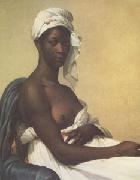 |
Marie-Guillemine Benoist
|
|
Paris 1768-1826
was a French neoclassical, historical and genre painter. She was born in Paris, the daughter of a civil servant. Her training as an artist began in 1781 under Élisabeth Vigee Le Brun, and she entered Jacques-Louis David's atelier in 1786 along with her sister Marie-Élisabeth Laville-Leroux. The poet Charles-Albert Demoustier, who met her in 1784, was inspired by her in creating the character Émile in his work Lettres Émilie sur la mythologie (1801). In 1791 she exhibited for the first time in the Salon de Paris, displaying her mythology-inspired picture Psych faisant ses adieux sa famille. Another of her paintings of this period, L'Innocence entre la vertu et le vice, is similarly mythological and reveals her feminist interests in this picture, vice is represented by a man, although it was traditionally represented by a woman. In 1793, she married the lawyer Pierre-Vincent Benoist. Her work, reflecting the influence of Jacques-Louis David, tended increasingly toward history painting by 1795. In 1800, she exhibited Portrait d'une negresse in the Salon. Six years previously, slavery had been abolished, and this image became a symbol for women's emancipation and black people's rights. This picture was acquired by Louis XVIII for France in 1818. An important commission, for a full-length portrait of Napol on Bonaparte Premier Consul Français in this period was awarded to her in 1803. This portrait was to be sent to the city of Ghent, newly ceded to France by the Treaty of Luneville in 1801. Other honors came to her; she was awarded a Gold Medal in the Salon of 1804, and received a governmental allowance. During this time she opened an atelier for the artistic training of women. Her career was harmed by political developments, however, when her husband, the convinced royalist count Benoist, was nominated in the Conseil d'État during the post-1814 monarchy come-back called the Bourbon Restoration. |
|

